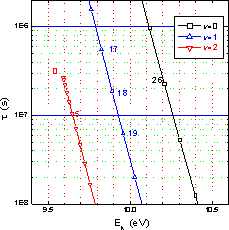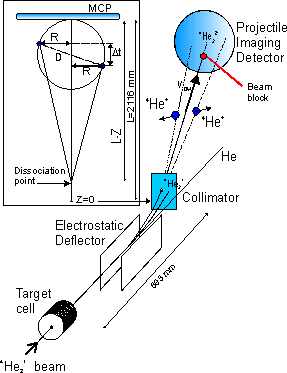
Figure 1: Calculated mean lifetimes, τ, and
KER values for many rovibrational states of 4He22+.

Figure 2: Schematic view of the experimental setup.
TUNNELING RATES OF ROVIBRATIONAL STATES OF METASTABLE 4He22+
I. Ben-Itzhak
J. R. Macdonald Laboratory, Department of
Physics, Kansas State University, Manhattan, KS 66506, USA
A. Bar-David, I. Gertner, and B. Rosner
Department of Physics, Technion, Haifa 32000, Israel.
The rovibrational states bound to the metastable electronic ground state of He22+ decay by tunneling through the potential energy barrier. The mean lifetimes and kinetic energy release upon dissociation for the heteronuclear 3He4He2+ isotope have been reported recently1. The measured values were in agreement with calculated high angular-momentum states (l around 14), and it was suggested that these states are populated by the mechanism creating the parent 3He4He+ in the ion source. However, the measurements were not sensitive to low angular momentum states and thus the width of the angular momentum distribution remains to be determined. To address this question we conducted similar measurements, of the mean lifetimes and kinetic energy release upon dissociation for the homonuclear 4He22+ isotope, for which both low and high angular momentum states are within the high sensitivity range of our experimental setup (50-500 ns), as shown in figure 1. Note that the v=0 states within the measurement window have very low angular momentum, while the v=1 and v=2 states have angular momentum of 17-19 and 26-27 respectively.
The experiment is done using 3D imaging of the dissociating fragments as described in detail by Bouhnik et al.2. One experimental change was needed to separate between He+ + He+ ion pairs from unimolecular dissociation and those from prompt dissociation during the collision. This was accomplished by placing a very small collimator, 0.3 mm in diameter, after the electrostatic deflector and by blocking the center of the imaging detector, as shown schematically in figure 2. This angular discrimination allowed only ion pairs from unimolecular dissociation to be detected, though not all of them. The measured results are consistent with v=1 states (l ~18).
Figures:

Figure 1: Calculated mean lifetimes, τ, and
KER values for many rovibrational states of 4He22+.

Figure 2: Schematic view of the experimental setup.
References:
1) I. Ben-Itzhak et al., submitted to J. Phys. B (2001).
2) J.P. Bouhnik et al., Phys. Rev. A 63, 0325xx (2001).
This work was supported by the
Chemical Sciences, Geosciences and Biosciences Division,
Office of Basic Energy Sciences,
Office of Science,
U.S. Department of Energy.
Submitted to ICPEAC 2001, July 2001 in Santa Fe, NM.
This abstract is also available in Postscript or Adobe Acrobat formats.
|
|